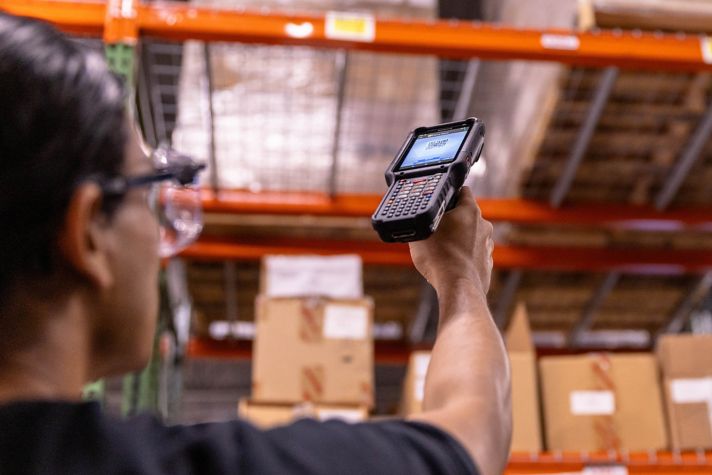-
Global
-
Africa
-
Asia Pacific
-
Europe
-
Latin America
-
Middle East
-
North America
- |
- BUSINESSES
- |
- Contact
- |
-
Global
-
Africa
-
Asia Pacific
-
Europe
-
Latin America
-
Middle East
-
North America
- |
- BUSINESSES
- |
- Contact
- |
You are browsing the product catalog for
You are viewing the overview and resources for
- News
- Embracing AI’s Impact on Shopping
Embracing AI’s Impact on Shopping
Whether you're shopping in-store or online, AI is working hard to enhance your experience and encourage you to swipe your card.
Picture this: You’re walking through a store when the perfect jacket catches your eye. You try it on and linger for a few minutes. Suddenly, a message pops up on your mobile phone. “Take 25% off jackets, today only.” It’s an offer you can’t refuse, and artificial intelligence (AI) is at the heart of it.
AI-driven technology gives retailers the power to deliver customer experiences never imagined just a few years ago.
For consumers who value the unified mix of online and in-store shopping, AI elevates personalized customer experiences that increase satisfaction and, in turn, brand loyalty.
“If stores fail to adapt to technology, they can quickly get left behind,” said Tony Boncore, who leads Honeywell’s In-Store Connected Retail Solutions portfolio.
To manage increasing customer expectations, supply chain concerns, and operational costs, nearly 6 in 10 retailers plan to launch AI, machine learning (ML) and computer vision (CV) technologies next year. That's according to a recent Honeywell retail technology survey of 1,000 retail directors across the US and Europe, the Middle East and Africa in IT, operations and customer experience roles.
Here are three ways AI-powered technology is changing the way you shop:
Accelerated knowledge and innovation
AI chatbots and virtual assistants can now deliver first-tier services online or by phone before customers are transferred to a live person. It’s a potentially time-saving element of an AI-driven service hierarchy that has become a part of many retail communication models.
In-store, AI is entrenched in nearly every service.
“There are a lot of social norms that are starting to affect shopper behaviors, which have a pretty significant impact on how retailers operate — how they merchandise products, what they showcase and where they showcase,” Boncore said. “That’s all because of what the behavioral impact of a shopper is dictating.”
To capture in-store insights, many retailers today look to computer vision — an AI-enabled, computer-based camera system that can track the general movements of in-store shoppers. The technology helps retailers optimize product placement, store layout and more.
Wi-Fi technology is key to the personalized experience of on-the-spot shopper discounts. As soon as people accept a store’s terms and conditions on Wi-Fi, they are saying “yes” to real-time location tracking, in many cases. That tracking can help customers save money while bringing value to the retailer.
Improved inventory accuracy
From restaurants to grocery stores to product retailers, the COVID-19 pandemic ignited supply chain turmoil and staffing shortages.
“The companies that flourished are the ones that reacted quickly,” Boncore said. “They advanced their technology investment. They advanced their technology development and deployment to meet business and customer needs.”
Computer vision, the same technology used to track shopper movements, is the power behind improved inventory controls. Robots move from aisle to aisle, scanning shelves to view stock availability. The robots scan product images rather than barcodes, providing the more accurate inventory details stores need.
With software-powered barcode scanning technology, workers can scan shelf tags to see what needs to be quickly restocked or identify and replace pricing mislabels.
For shoppers, the result is better-stocked shelves and improved online accuracy of what’s available to pick up locally in stores. “You can’t have a great customer experience without the right inventory,” Boncore said. “The inventory component is important to success.”
Strengthened customer service
Customers hold the purchasing power. If they see five items available online at one price and visit a store and see a different price, retailers need to solve the problem quickly.
Shoppers no longer want to wait for the manager to arrive. They want faster service the ability to scan a ticket on the store shelf and pull up product data. What’s the price? What’s the fabric? How should I wash it? Is this food product gluten- and nut-free?
Mobility devices are the backbone of retail operations. In an industry where devices can often go missing, ensuring devices are well-managed is essential for efficiency. Software that analyzes device data and translates it into actionable insights allows retailers to free up store associates and focus more on the customer.
Additionally, at home or in store, opportunities for customers to create a virtual experience through AI-powered computer vision are game-changing — whether it’s trying on a new sweater or trying out a new sofa, virtually. An excellent customer experience is the gold standard all retailers want and shoppers deserve.
Boncore said: “Customers want to feel like the retailer knows them better than their best friend.”
Learn more about technology transforming the retail experience in the full report, Navigating the AI Revolution.
Retailers say they are planning to use AI to improve customer satisfaction, brand loyalty and business operations.
Copyright © 2025 Honeywell International Inc.



